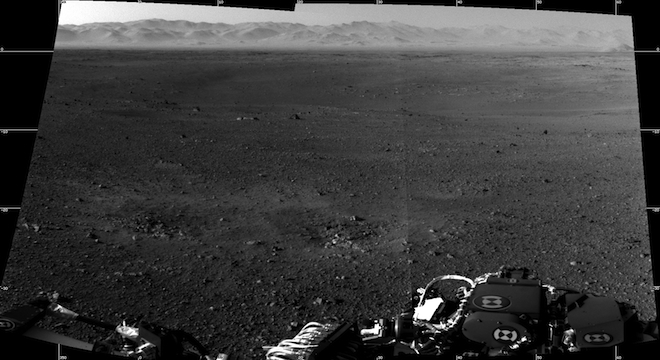Updated 6:24 p.m. ET, Wednesday, August 8
NASA’s Mars Curiosity Rover has only been on the surface of the Red Planet for two days, but several of the robot’s 17-different cameras are hard at work, sending back new, higher-quality images of the Martian landscape as well as of the rover itself.
NASA has also posted more, higher-resolution images of Curiosity’s elaborate and risky descent.
NASA on Wednesday published the following composite black-and-white image — actually two separate views of the Martian landscape snapped by the Mars Curiosity Rover’s twin mast cameras, or Mastcam.
The images, which are the first taken by the rover in full-resolution, 1024 by 1024 pixels (click to see the full res version), show its immediate surroundings. The rocky, mountainous-looking features in the distance are actually part of the rim of the Gale Crater, a massive 90-mile-diameter depression located in the northwestern section of the planet created by an impact billions of years ago. Scientists believe that the crater’s shallow floor may have once been covered by liquid water. You can explore an interactive satellite view of the crater yourself here.

Contrast that placid scene with a new full-resolution view of the rover’s dramatic descent to the surface of the Red Planet, also posted online by NASA on Wednesday.
The view shows in unprecedented detail the rover landing craft ejecting its heat shield just before the rover itself was about to touch down on Mars. In this view, the heat shield is about 50 feet away from the rover’s Mars Descent Imager camera, or MARDI, which snapped the image. The individual rivets on the heat shield can be clearly seen, as well as the two white circles, which are calibration targets for the MARDI camera.

The view is the same one seen in a lower-resolution video composite of thumbnail images of the descent published by NASA on Monday. NASA tweeted on Wednesday from its Mars Curiosity rover Twitter account that a full high-resolution video would be published soon as well.
Finally, NASA on Wednesday also published a striking 360-degree composite image of the rover itself, sitting on the Martian surface. The view, which NASA admits is “Picasso-like,” was snapped by the rover’s twin navigation cameras, or Navcams, which are also located on its mast, which reaches 3.6 feet when fully extended. The images were snapped as the mast rotated around the rover looking straight down.

As NASA points out, most of the images are lower-resolution thumbnails, but two of them (in the upper right quadrant) of the picture are full resolution.
It’s also important to keep in mind that Mars Curiosity Rover hasn’t even officially begun its two-year scientific exploration mission yet: The past two days have been all devoted to checking out the rover’s equipment, including the 10 different instruments onboard. The rover won’t begin analyzing the Martian soil and geology for another few days, possibly next week. When it does, scientists are hoping to find out whether Mars ever had the environmental conditions capable of supporting carbon-based microbial lifeforms.
Late update: NASA’s Jet Propulsion Laboratory in Pasadena, California, the division that designed the Mars Curiosity Rover and is in charge of its operation, published the following video close-up of its landing site late Wednesday afternoon:
Correction: This article originally stated that the Curiosity rover had nine different cameras, when in fact it has 17. The article also incorrectly cited the height of the rover’s mast at 7 feet, when it is in fact just 3.6 feet tall. We apologize for the errors and have updated the story in copy to correct them.






